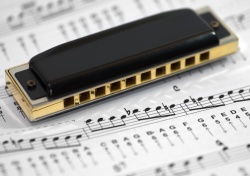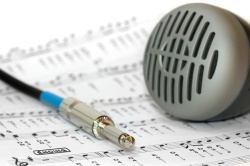Amazing Grate – First Steps On Those High End Holes
 How strange the sound
How strange the sound
Young Malcolm called into the Harp Surgery today, hot on the heels of our Harpin’ By The Sea event. Having witnessed Will Greener’s performance of Amazing Grace, he was keen to revisit the tune from scratch.
Using a C major 10 hole diatonic, we knew that the tune can be played using 7B as the root. But while this avoids any nasty bends, it does sound rather shrill. Also, as a beginner, it demands a strong embouchure and some dexterity around a specific triplet of notes.
That foxed a wretch like me
Let’s look at the tab for Amazing Grace on the upper end of the harmonica. Try to play the notes cleanly and with full tone.
6B 7B 8B..8D..7B 8B
8D 7B 6D 6B
6B 7B 8B..8D..7B 8B
8D 9B 9B
8B 9B 9B
8B..8D..7B 8B
8D 7B 6D 6B
6B 7B 8B..8D..7B 8B
8D 7B (7B)
I once was lost, but now I’m found
 Malcolm found that playing his high end notes produced intermittent squalls. Also that 8D was virtually impossible. So we went went back to the drawing board.
Malcolm found that playing his high end notes produced intermittent squalls. Also that 8D was virtually impossible. So we went went back to the drawing board.
Firstly we established the hidden culprit was his tongue. Instead of remaining neutral and away from the harp, Malcolm was using his tongue to search for the holes and inadvertently squeezing blow bends or jamming draw reeds in the process.
To redevelop embouchure and control, we placed one hand on his diaphragm, then began breathing gently and slowly through the arpeggio 10B-9B-8B-8B-7B-8B-9B-10B. Closing our eyes, we repeated this up and down several times. It’s the simplest of exercises, but our focus was on accuracy, tone and most importantly breathing from the diaphragm, without interruption from the tongue or throat. We sensed our breath transferring from hole to hole across each bridge of the harmonica and understood how this alone can assist and direct accurate playing. Time now for the draw notes.
Next we worked on pushing and pulling from the diaphragm, again leaving the tongue out of the equation. We chose the pattern 10B-10D-9B-9D-8B-8D-7B and back again. A relaxed posture, closed eyes, an open vocal tract, a resting tongue and unforced breathing all contributed to curing Malcolm’s problem. As did keeping one hand on his diaphragm. Trusting to good embouchure and his breath alone, Malcolm had eliminated his squalls on the blow and his mute reeds on the draw.
Was blind, but now I see
 Eyes open again, Malcolm revisited the Amazing Grace tab, playing through slowly and learning to navigate the patterns, especially that tricky triplet sequence. Homework this week? More of the same.
Eyes open again, Malcolm revisited the Amazing Grace tab, playing through slowly and learning to navigate the patterns, especially that tricky triplet sequence. Homework this week? More of the same.
Next lesson we’re looking at Amazing Grace again, but on the lower end of the harp. Which mean executing the 3D” necessary to complete the melody. Twas Grace that brought us safe thus far, and Grace will lead us home. Keep the faith!
